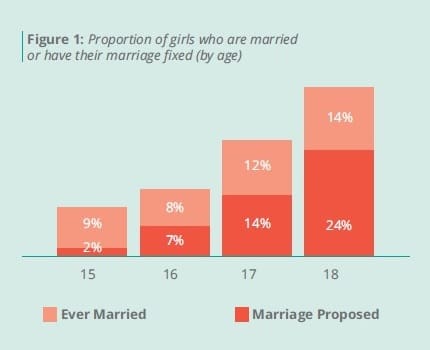
UMANG: Raising Her Voice
Adolescent Girls, Child Marriage, Education, Intimate Partner Violence, Violence Against Women and Girls
Agency and Aspirations of Adolescent Girls on Marriage | Evidence from Jharkhand, India
2020
Early, child and forced marriage (ECFM) is a violation of a girl’s right to grow in a safe environment, receive education and realize her full potential. It compromises all efforts to overcome poverty, fight for gender equality, advance girls’ education and improve their overall health and well-being.
 Several studies strongly suggest that unequal gender norms provide social sanctions and justifications to sustain child marriage practices, which affect a girl’s health, including maternal morbidity, mortality and nutritional status. There is also an inter-generational impact on the survival and health of her children. ECFM is also linked to a higher probability of girls experiencing intimate partner violence, making it less likely for them to seek and receive the necessary support.
Several studies strongly suggest that unequal gender norms provide social sanctions and justifications to sustain child marriage practices, which affect a girl’s health, including maternal morbidity, mortality and nutritional status. There is also an inter-generational impact on the survival and health of her children. ECFM is also linked to a higher probability of girls experiencing intimate partner violence, making it less likely for them to seek and receive the necessary support.
In India, there is legislation in place that prohibits child marriage, and there are programs to address the issue. To reduce the prevalence of child marriage, ICRW, SATHEE, Badlao Foundation and Project Concern International are implementing a comprehensive multi-layered girls’ empowerment program called UMANG. With support from the IKEA Foundation, the program is expected to reach around 200,000 adolescent girls, men and boys and community members from four blocks of Godda and Jamtara districts over the four-year program period.
This research report presents findings from the UMANG program’s baseline survey on marriage practices among adolescent girls aged 15-18 years, and their aspirations and role in decision-making with respect to their marriage.
Key Findings:
- Among girls aged 15-18 years, 11 percent were married, and marriage was fixed for another 12 percent.
- Out-of-school girls are 3.4 times more likely to be married or have their marriage fixed than girls still attending school.
- Among married girls, the average age at marriage was 16 years, approximately two years earlier than when they would have liked to marry.
- Among unmarried girls, the desired mean age at marriage is 20 years.
- Most unmarried girls perceived that they have little say in marriage-related matters and decisions, particularly with respect to the timing (86 percent) and choice of partner (87 percent).
- Overall, 82 percent of girls felt that their father is the main decision-maker on matters of marriage.
- Most girls (80 percent) recognized the negative implications of early marriage, and supported the need for attaining education and achieving career aspirations before marriage. However, only 43 percent agreed that it is appropriate for girls to express dissent if they do not like their parents’ choice of partner.

Discussion:
With growing awareness and aspirations among girls and parents to prioritize education over marriage, there are opportunities for engaging different stakeholders to challenge and change ECFM-related practices. UMANG recognizes that girls, parents, and community members are embedded in a larger normative system and a part of key structures and institutions. With this in mind, the program engages with institutions and structures, and positions different intervention components within the system for larger and sustained change.
The research reported in this publication has been conducted as part of the UMANG program. UMANG is being implemented by ICRW Asia, in partnership with SATHEE, Badlao Foundation and Project Concern International, in close association with the Government of Jharkhand, and with financial support from the IKEA Foundation. The facts and information in this report may be reproduced, quoted or cited only for non-commercial use and with appropriate attribution.
Suggested Citation:
Achyut, Pranita; Khurana, Nalini V.; Reddy, Hanimi; Gautam, Abhishek & Verma, Ravi K. (2020). Raising Her Voice: Agency and Aspirations of Adolescent Girls on Marriage — Evidence from Jharkhand, India. New Delhi: International Center for Research on Women.
